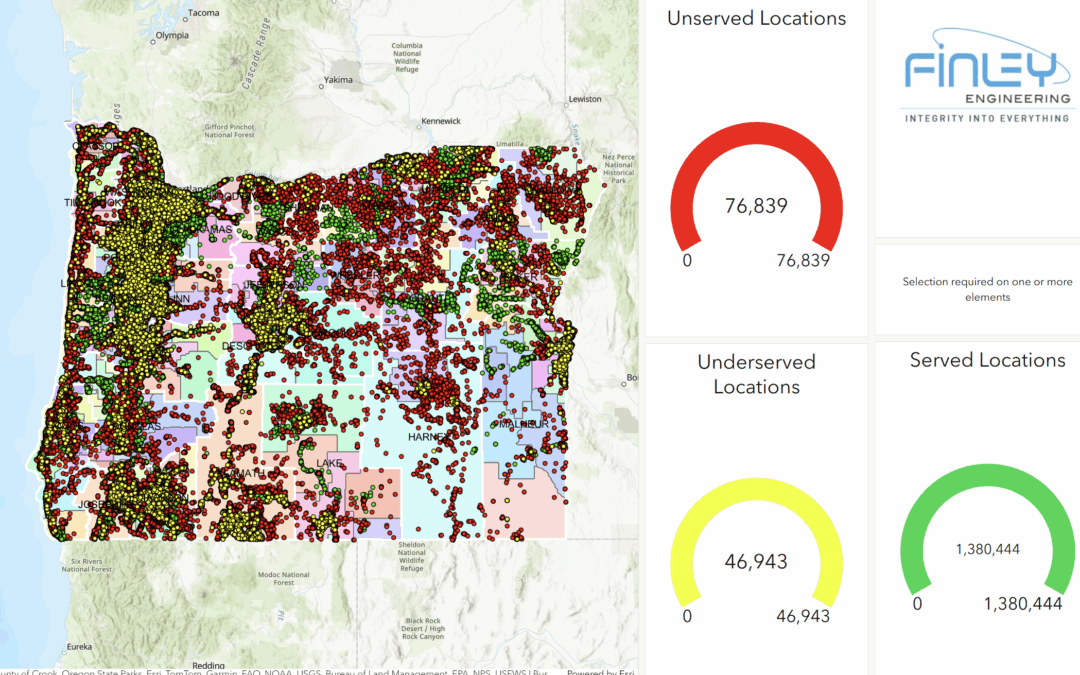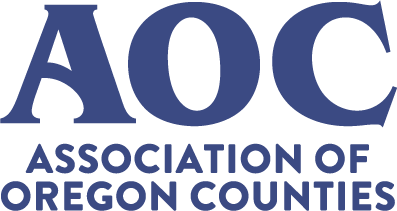
Apr 25, 2025 | AOC Business Partner
Sponsored content contributed by AOC Business Partner: Finley
Bringing Better Broadband to Oregon’s Counties
The Broadband Equity, Access, and Deployment (BEAD) Program represents Oregon’s most significant opportunity in a generation to bridge the digital divide. As counties throughout the state evaluate the best ways to deliver high-speed internet to unserved and underserved regions, the Association of Oregon Counties has a vital role to play — and Finley is ready to assist.
What is BEAD?
BEAD is a federal program that aims to expand high-speed internet access for every American, especially in rural and underserved areas. Oregon’s BEAD initiative is managed by the Oregon Broadband Office (OBO), which has divided the state into coverage areas aligned with the school district system.
Oregon received $689 million of funding through BEAD, based on metrics like service availability and need, and is currently deploying those funds. The 2020 SNG report to the OBO highlighted how widespread the need is, particularly in rural counties. This report clearly shows the demand for reliable connectivity and reinforces that Oregon will still fall short even with BEAD funding. Access the OREGON Broadband Study here.
Discover how Finley can help your county connect by clicking on “The Finley Connection.”
Why It Matters to Your County
Your county stands to gain tangible and measurable benefits from BEAD-funded broadband expansion in several ways.
Tourism: By directly contributing $14 billion and 118,000 jobs, tourism and broadband connectivity help to generate revenue for Oregon counties. Increased connectivity and tourism foster an environment that attracts visitors, remote workers, and events, encouraging Oregon’s guests to stay longer and spend more, ultimately enhancing your county’s success.
Improved Metrics: Better connectivity means improved access to healthcare, education, and economic opportunity for all Oregonians.
Agricultural Advancements: Modern agriculture depends on reliable internet, from cattle tracking, wheat storage, production automation, and irrigation systems.
Economic Growth: Studies show a clear link between broadband expansion, increased county GDP, increased tax base, job creation, and long-term generational prosperity. (See: CORI Report)
IoT Innovations: From soil sensors to automated chemical-free weed control to grain bin automation, modern ag tech depends on strong broadband infrastructure.
How Your County Can Shape BEAD’s Success
Depending on goals, resources, and local conditions, counties can engage with BEAD in multiple ways.
Public-Private Partnership: Directly apply for BEAD funding and subcontract providers to meet county-set goals.
Public Ownership: Apply to OBO to build a publicly operated broadband network.
Commit Matching Funds: Facilitate a local RFI or RFP process and back the provider(s) who align with your county’s priorities.
Show Support: Provide letters of support or advocacy for private applicants requesting funding.
Each approach offers benefits, but also complexities.
What Comes Next?
Now is the time for counties to take action:
Engage with the OBO: Learn the latest on your area’s eligibility and advocate for your community’s unique needs.
Understand the Process: The BEAD program is technical, jargon-heavy, and fast-moving. Ensure you have the right knowledge and allies on your side.
Utilize Expert Partners: This is where Finley can help.
At Finley, we focus on assisting counties like yours in navigating the broadband process—from identifying funding opportunities and forming partnerships to creating strategies that align with local priorities.
We have partnered with clients nationwide, giving us the insight and experience necessary to support your county at every stage. From public-private partnerships to grant writing, engineering design, and community engagement, Finley is your advocate in BEAD.

Apr 25, 2025 | AOC Business Partner
Sponsored content contributed by AOC Business Partner: Covenant Global
Securing data from cyberattacks is no longer a background issue — it’s an urgent and daily concern for individuals, government entities, and critical infrastructure. Cyber threats targeting local governments have surged, with attacks leaking personal data to the dark web, exposing vulnerabilities in infrastructure, or deploying undetected malware like Project Sauron — which operated silently for five years.
Oregon’s municipalities are under pressure to defend against constant and sophisticated attacks, all while staying compliant with a growing list of regulatory frameworks. The State of Oregon’s Cyber Security Plan outlines mandatory compliance with frameworks like:
- FTI (taxpayer information)
- HIPAA (health records)
- FERPA (education records)
- PCI-DSS (payment data)
- CJIS (criminal justice)
At first glance, the number of overlapping standards may seem overwhelming, if not impossible to track. Adding to the pressure, the plan also mandates alignment with National Institute of Standards and Technology (NIST) 800-53, a deep catalog of 1,500+ security controls. But here’s the good news: most of these frameworks are built on NIST 800-53. Understanding this simplifies compliance, turning a complex challenge into a manageable checklist.
NIST 800-53 isn’t just another requirement — it’s the foundational blueprint trusted by federal agencies and adopted by leading states. It provides the widest range of security controls, purpose-built for diverse government scenarios. That’s why Oregon chose it—and why local governments can trust it to scale with their evolving needs.
Additionally, the NIST Cybersecurity Framework (CSF) helps municipalities not only select the right controls but also implement them strategically. These tools work in tandem:
- 800-53 = the “what” of security
- CSF = the “how” of implementation
A great example? The Lower Colorado River Authority (LCRA) successfully leveraged both to harden infrastructure while simplifying compliance.
The bottom line: Oregon municipalities don’t need to reinvent the wheel. By aligning with the NIST 800-53 and CSF — both purpose-built by U.S. authorities for public-sector resilience — counties can efficiently secure systems, simplify compliance, and better protect their communities. Now is the time to act.
Contributing Author: Daniel Dolinov, Senior Compliance Consultant, Covenant Global

Apr 24, 2025 | AOC Business Partner
Sponsored content contributed by AOC Business Partner: Energy Trust of Oregon
Disruptions in federal funding are creating uncertainty for energy and climate programs across the country, including some supported by the Inflation Reduction Act. Amidst this uncertainty, Energy Trust of Oregon remains a consistent resource to help people, businesses and communities throughout Oregon and Southwest Washington access energy-efficient solutions and renewable power.
Energy Trust was created by the Oregon Legislature more than 20 years ago as an independent nonprofit dedicated to helping utility customers lower energy costs and generate renewable power. It is funded largely by customers of Portland General Electric, Pacific Power, NW Natural, Cascade Natural Gas and Avista.
One of the ways Energy Trust continues to serve the people of Oregon and Southwest Washington is by supporting city and county governments in their goals to advance a clean energy future that builds resilience, promotes equity and supports economic vitality. It does this by providing cash incentives, technical expertise and more. Support includes:
- Building upgrades for businesses, offices, hospitals and government buildings, such as funding new heating and cooling systems in schools to create a more comfortable learning environment for students.
- Early design assistance and energy studies for new buildings and major renovations to incorporate the most efficient technologies and methods.
- Energy storage for critical infrastructure and core municipal services, such as installing batteries with a solar energy system to provide backup power during an outage.
- Resilience planning to increase community sustainability, including fire resistant building practices, efficient indoor cooling and locally generated renewable energy.
- Renewable energy project development assistance and installation incentives, such as installing hydropower in city water systems for clean, reliable energy or developing community solar projects to lower bills for households unable to install their own solar panels.
- A network of experienced local contractors to provide tailored solutions based on the specific needs of various industries.
Energy efficiency upgrades make living and workspaces safer, more comfortable and more affordable to operate. Additionally, by investing in energy efficiency and renewable energy projects, cities and counties can meet sustainability goals and reduce operating costs that help free up funds for core services.
Energy Trust is and continues to be here to provide reliable support and practical solutions to help cities and counties thrive. Learn more about Energy Trust and clean energy solutions at www.energytrust.org.



